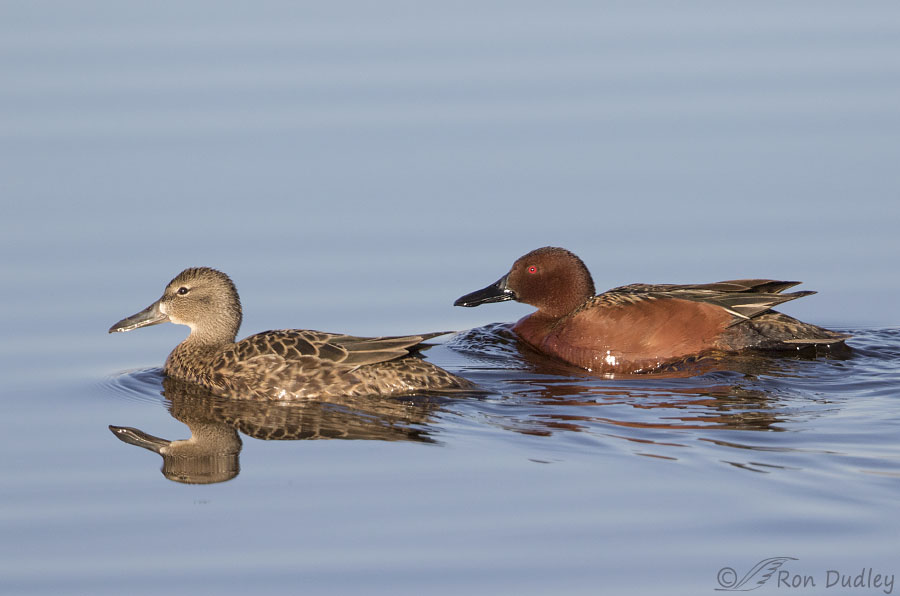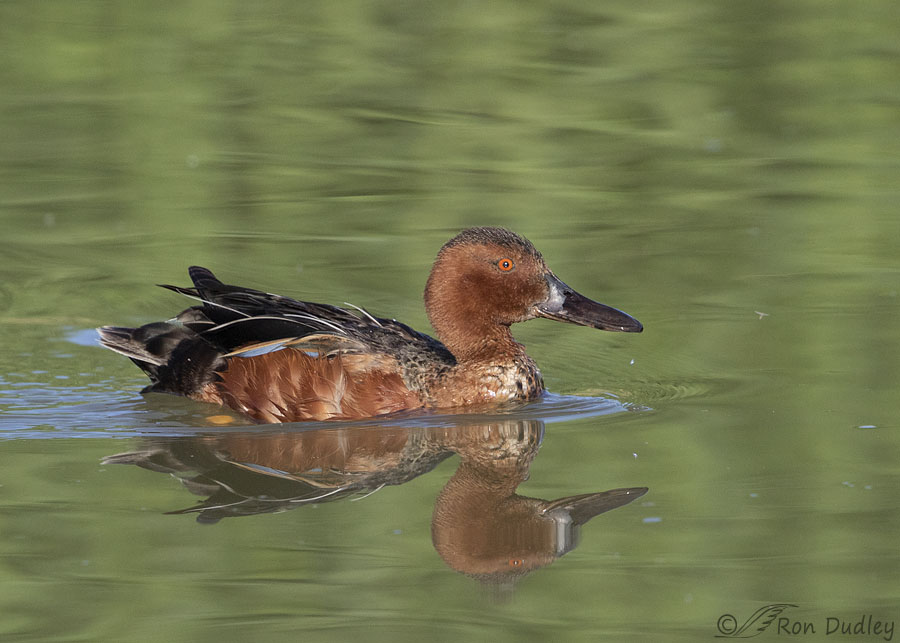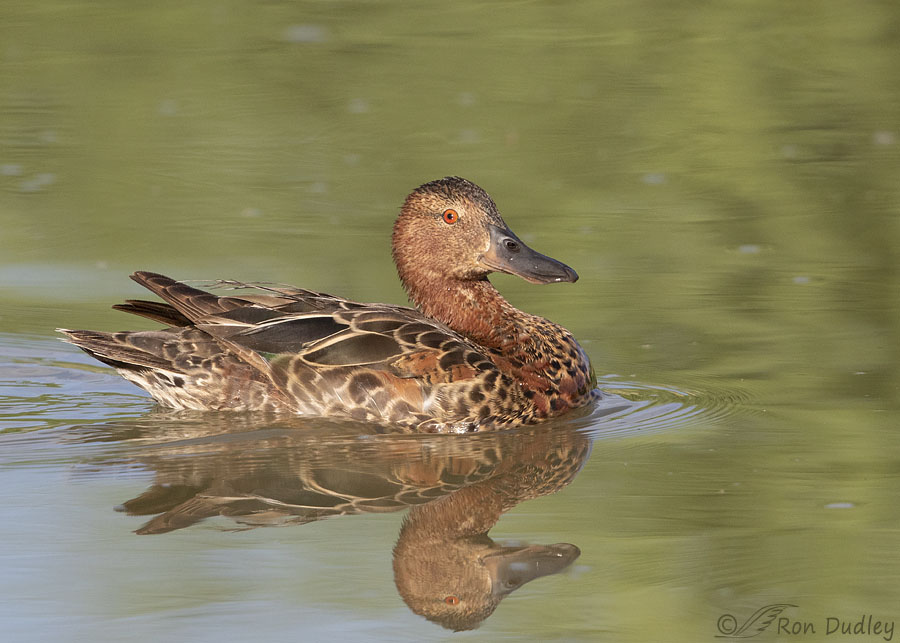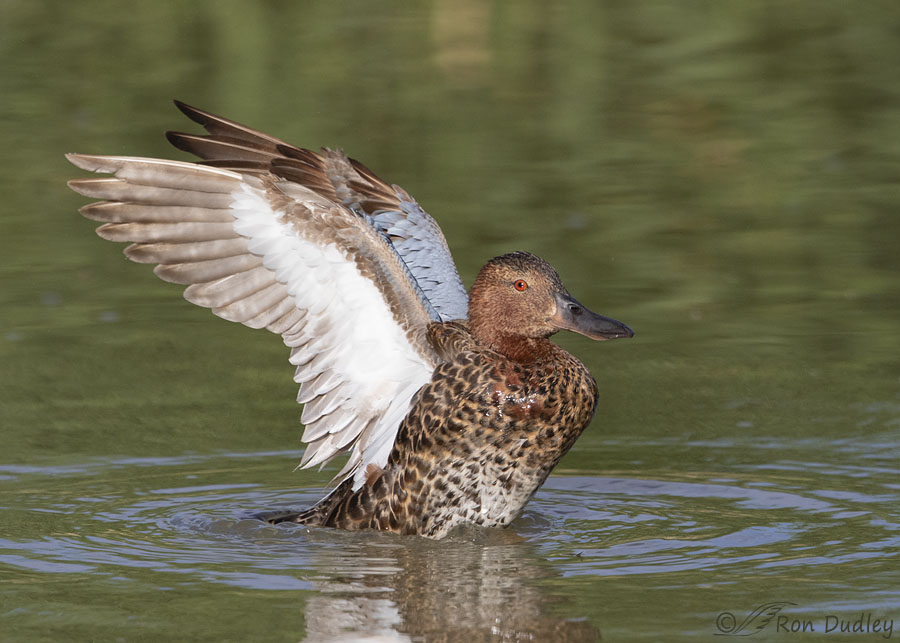Yesterday morning at Bear River MBR I encountered a male Cinnamon Teal that had me a little confused at first.

First as background let’s look at typical breeding plumage of Cinnamon Teals. This is a mated pair with the female on the left and the male on the right. The dark reddish-brown (cinnamon) plumage of the male is distinctive and unmistakable.
This photo was taken on April 25 two years ago but the following three photos were all taken yesterday.

1/2500, f/6.3, ISO 800, Canon 7D Mark II, Canon EF 500mm f/4L IS II USM + EF 1.4 III Extender, not baited, set up or called in
I saw a fair number of males yesterday and most of them looked about like this one. This time of year most of their cinnamon color is still intact but some changes are beginning to occur, most noticeably in the lower neck and upper breast where the cinnamon color is being lost and replaced by the more drab colors of non-breeding (eclipse) plumage.

1/3200, f/6.3, ISO 800, Canon 7D Mark II, Canon EF 500mm f/4L IS II USM + EF 1.4 III Extender, not baited, set up or called in
So when I saw this bird I was confused at first because it was so very different from the other males in the area. Was it a male going into eclipse plumage earlier than the other males or a female that was more red than most?
I’m far from an expert on duck ID or plumages so in the field I wasn’t sure.

1/3200, f/6.3, ISO 800, Canon 7D Mark II, Canon EF 500mm f/4L IS II USM + EF 1.4 III Extender, not baited, set up or called in
When the same male performed a wing flap I was even more confused.
But the red eye is key – only adult males have red eyes and I hadn’t noticed the eyes of this bird in the field. So this is a male going into eclipse plumage earlier than most of his buddies. Besides, I’ve never seen a female with this much red (both sexes have a blue speculum).
I’ve got to work a little harder on my ducks. I’ve been telling myself that for years but this bird brought it to the fore again.
Ron


Time passes so quickly with the ducks, it is so important to get out during the months of May -June or I miss it. This reminds me to keep getting out in the field as much as I can. And record what I see, as Dick mentions.
Vey informative post. And now I know what a speculum is. I think.
I think you do. Thanks, Lyle.
Huge thanks to you and to your knowledgeable commentators.
From a largely ignorant but concerned perspective Dick Harlow’s comment struck home. This is something which worries me. A lot. And plumage changes could be the tip of the proverbial iceberg.
Thank you, EC.
Nice plumage discussion. On another subject , I don”t remember seeing any recent raptor postings. No Swainson’s, for instance. What’s the explanation? Thanks, John
You’re right, John. I’ve had very little luck with raptors lately and it isn’t because I haven’t tried. Hard! Part of it is that I’m seeing far fewer buteos than I used to.
I do have hopes for some fledgling red-tails in the near future.
From what I know on waterfowl, after breeding season has wound down, the drakes go through a molt where they lose there bright colors and resemble hens. Actually, even hens molt. The division gathers geese during these molt periods, because during this time they are not really able to fly as well either, and the young have not gotten their flight feathers yet either. I think part of the reason they change to the drab colors is so during this flightless time, they have better camouflage to protect them from predators. The bright colors and flight feathers return closer to fall and then remain through the winter.
Yup, that’s what happens, Travis.
Really incredible change. I am partial to that breeding plumage.
I”m partial to it too, Arwen.
Could it be a late first year male? Some birds do a molt between juvenile and full adult breeding plumage. Perhaps it is just late to adult coloration? I don’t know much about ducks either, but I have seen some funky feathers on the “betweens” in passerines.
I guess it’s possible, April. I just don’t know.
As an expert in duck plumage —
For my next joke —
I’ll make a substantial comment just as soon as I get over my jealous sulking about your superb photographs of a bird I’ve only been able to see a few times at a distance of about 100 miles.
Great post, Ron!
Wally, I see them often but the male’s distinctive color still blows me away.
Beautiful shots Ron, and very fortunate timing that you were there just at the right time to see this change in plumage. Without the photos and taking the time to investigate one could easily have assumed that is a female. Good research on your part.
That bird had me stumped at first but then I’m easily fooled in situations like this. Thanks, Everett.
OK, I’m going to throw something out here that has bothered me for several years, thinking I had no real proof other than normal evolution.
I have noticed changes generally in plumage’s, changes in behaviors of various birds, organisms and mammals. Maybe it is my distrust in human and business use of chemicals, toxins, change in climate, etc., but why couldn’t some of these anomalies that we see be the result of what we are doing to wildlife food supply and the air they breath? I tend to believe that toxins stay in the water, in the soil and in the air we breath over time, concentrated in some areas more than other areas, but they are there just the same and over time will have an affect on plumage, genes, and behavior. I feel when we see these changes we should document them, keep records and let science know what we have observed. Sorry, just my 2 cents.
I couldn’t say either way, Dick. But as far as I know plumage variations like this are fairly common in many birds and have been for years.
Yes Ron, I understand that, but if you read Bent’s Life Histories, taking note of what was observed when these books were written, there have been changes. Subtle but still changes. Maybe in some cases it is in behavior, others it might be more noticeable. Just sayin, we should write down our observations and be vocal like what you are doing now. Many thanks!
I’m not saying you’re wrong, Dick. In fact I’m pretty sure you’re right in at least some instances.
But we both know that variation is an integral part of the genetics of most organisms so it can be very difficult to know which effect is responsible. Overall patterns may be another story.
Interesting! The casual observer(me) wouldn’t pick up on what was happening…..probably just wonder where all the males went too..
The casual observer(me) wouldn’t pick up on what was happening…..probably just wonder where all the males went too..  Great documentation of what was/is going on there and lovely photos of all the ducks.
Great documentation of what was/is going on there and lovely photos of all the ducks.
That would be my first impulse too, Judy. But the more I looked at my photos the more confused I became so I pursued it.
Male ducks in eclipse plumage are difficult for me, too. It also appears that the bill color is different between the Cinnamon Teal sexes, which would be more apparent with binoculars.
Here in Madison, Wisconsin, most pairs have not been together for several weeks. The males are still obvious but most of the females are not easy to see. I don’t know where the females that had ducklings earlier have gone and the others in the neighborhood must be on nests.
I’ve noticed that bill color difference too, Pam. I didn’t mention it because in Sibley they look almost the same during breeding season in his illustrations so I’m not sure how reliable that field mark is and Cornell’s BNA Online was down for maintenance until a few minutes ago.